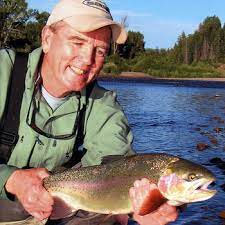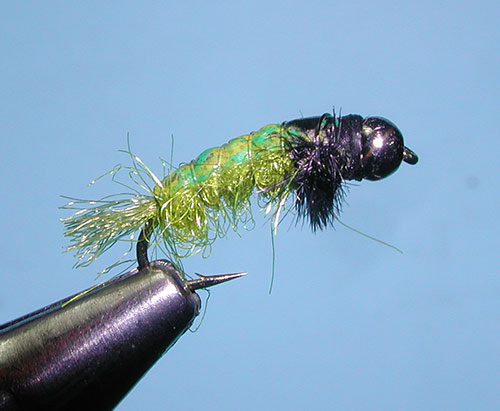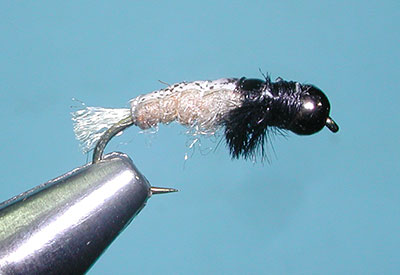Notes:
 John Barr came up with this pattern in the 1980's while fishing the Colorado River below State Bridge, Colorado. John noticed that caddis larva was the bulk of the trout's diet during a hatch yet fly fishermen often did not fish the larva pattern. Caddis larva are usually found in highly oxygenated riffles through out the west. We have great populations on the Owens, Kings, American, and Feather Rivers. The caddis larva are generally 0.5 to 1.5 inches and are in shades of green and tan. The Uncased Caddis represents the genus Hydropsyche, also known as the Gray Caddis or the net-spinning caddis. This type of caddis is free-living and caseless using a silk net to attach to the bottom. At times, these caddis will drift the current seeking other habitat and this is the time that the trout will key upon them. This behavioral drift occurs usually under low light conditions. Increased water current will also dislodge these larva and is known as a catastophic drift. John's pattern uses a tuft of Z-lon for the appendage you find on the rear of the larva. The body has a distinct segmentation and this is represented by a shellback strip that is ribbed with monofilament. John originally used ziplock bag material but switched to Thin Skin. Fino Skin is another material, similar to Thin Skin, and will work fine for this pattern. The shellback is darkened with a marker above the abdomen to represent the darker thorax and head. Ostrich herl represents the legs and a heavy tungsten bead will keep this pattern close to the bottom of the stream. John Barr came up with this pattern in the 1980's while fishing the Colorado River below State Bridge, Colorado. John noticed that caddis larva was the bulk of the trout's diet during a hatch yet fly fishermen often did not fish the larva pattern. Caddis larva are usually found in highly oxygenated riffles through out the west. We have great populations on the Owens, Kings, American, and Feather Rivers. The caddis larva are generally 0.5 to 1.5 inches and are in shades of green and tan. The Uncased Caddis represents the genus Hydropsyche, also known as the Gray Caddis or the net-spinning caddis. This type of caddis is free-living and caseless using a silk net to attach to the bottom. At times, these caddis will drift the current seeking other habitat and this is the time that the trout will key upon them. This behavioral drift occurs usually under low light conditions. Increased water current will also dislodge these larva and is known as a catastophic drift. John's pattern uses a tuft of Z-lon for the appendage you find on the rear of the larva. The body has a distinct segmentation and this is represented by a shellback strip that is ribbed with monofilament. John originally used ziplock bag material but switched to Thin Skin. Fino Skin is another material, similar to Thin Skin, and will work fine for this pattern. The shellback is darkened with a marker above the abdomen to represent the darker thorax and head. Ostrich herl represents the legs and a heavy tungsten bead will keep this pattern close to the bottom of the stream.
The pattern is usually fished as a two fly rig within a nymphing rig as the bottom fly. You can also use this pattern within a Hopper-Dropper rig. 4X or 5X Fluoro tippet is preferred.
|



